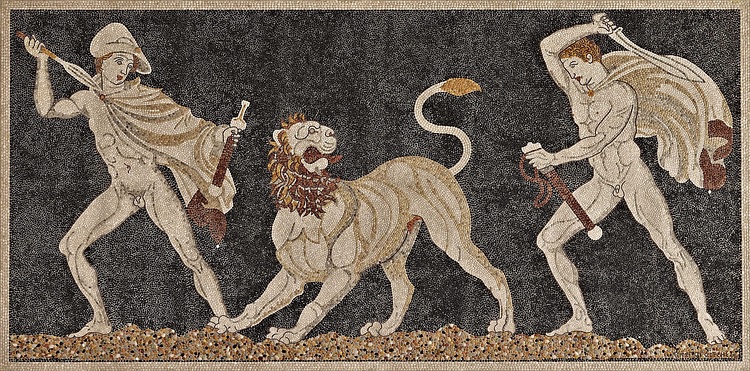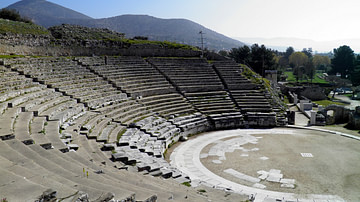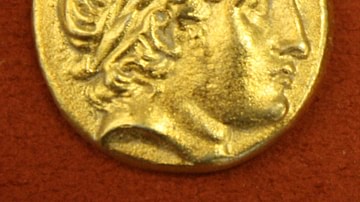Excavations at Vergina in northern Greece in the late 1970s CE unearthed a cluster of tombs thought to be the burial site of Philip II (r. 359-336 BCE), the father of Alexander the Great (r. 336-323 BCE), with a wife interred in a vaulted chamber beside him. Weapons, armour, gold and silver artefacts lay beside precious ossuaries containing cremated bones in these unique tombs close to the necropolis of Aegae, the ancient capital of Macedon. Since then anthropologists have been studying the remains for clues to the lives, deaths, injuries and funeral rites of the buried royals to prove their identities in the face of four decades of competing claims. A new generation of forensics has turned up surprising results and taken us closer to establishing just who was buried and when. Materials on the remains, melted gold on bones, and a crippling leg wound reveals a limping warrior woman revered as an 'Amazon' at death, and a king adorned with a gold wreath and ceremonial shield as the flames climbed the pyre in emulation of a Homeric hero.
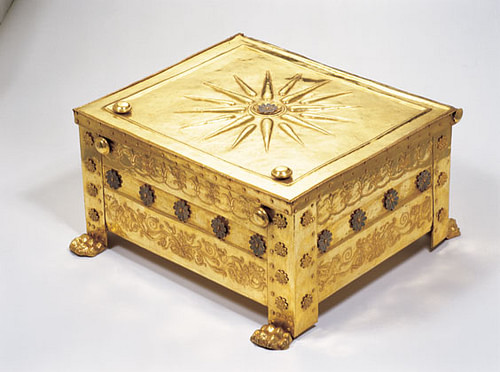
Discovery
It is now 42 years since Professor Manolis Andronikos, the head of excavations at Vergina in northern Greece, discovered an unlooted Macedonian tomb, the burial site of the family of Alexander the Great. By November 1977 CE, 60,000 cubic metres of soil had been carefully removed from the 100-metre-high and 12-metre-wide earthen hill known as the “Great Tumulus” in order to reveal the tomb's façade. 50 of the 51 tombs already discovered in what was once the heartland of ancient Macedon had been robbed in antiquity, but on that day and following a century of barren digs, the lost city of ancient Aegae was convincingly identified.

Scattered about the main chamber of the barrel-vaulted structure labelled “Tomb II” were sumptuous gold and silver artefacts with finely crafted ceremonial weapons and uniquely fashioned armour; a horde of invaluable grave goods. Within a stone sarcophagus rested a gold chest containing carefully cremated bones of a man wrapped in the remnants of purple fabric. In a further gold ossuary in the adjacent antechamber and similarly wrapped in textile were the cremated bones of a woman, arranged with a beautiful diadem of gold.
Tomb II resided in a cluster of four; “Tomb I” was a simpler cist grave which had already been looted in antiquity, but it was adorned with a gorgeous wall painting depicting the chthonic mythical theme known as “the Abduction of Persephone.” Immediately adjacent were the foundation stones of what appeared to be a shrine, suggesting the tomb occupant was being worshipped. A further unlooted structure labelled “Tomb III” contained the bones of an adolescent, probably a boy, and it was soon referred to as the “Tomb of the Prince.” The last structure to be unearthed, “Tomb IV,” lay in ruins apart from free-standing columns framing the entrance to the largest and deepest chamber of all positioned at the very edge of the tumulus.

The scattered artefacts in Tombs II and III were broadly dated to the mid-to-late 4th century BCE, stylistically corroborated by pottery, metal banqueting accessories and the evolving tomb design itself. The unique “Vergina Sun” or “Star” symbol of the royal clan of Macedon was embossed on the lids of the two gold chests holding the cremated bones.
The Cluster of Philip II
The four-tomb grouping became known as the “cluster of Philip II”, as the excavator believed Tomb II held the remains of Philip II (r. 359-336 BCE), the first king to unite ancient Macedon. His military reforms and statecraft brought Greece to its knees, enabling his son, Alexander the Great (r. 336-323 BCE), to conquer the Persian Empire. Philip was a cultured cunning diplomat whose polygamous court hosted seven wives whose name-order survives in the text of the antiquarian Athenaeus.
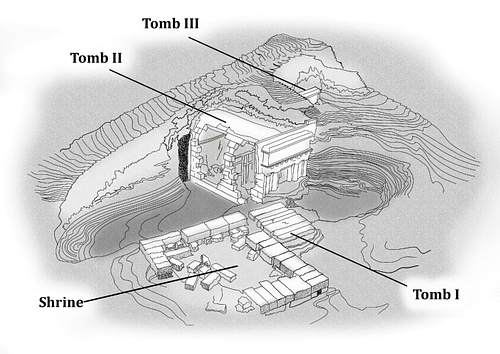
Although the political capital of Macedon had been moved from Aegae to Pella a century before Philip's reign, it remained the ceremonial home of the kings. In October 336 BCE, Philip was stabbed to death at his daughter's wedding at Aegae; it was a world-shaking event that heralded in Alexander's kingship. Alexander conquered the Persian Empire in eleven years but died in mysterious circumstances in Babylon in 323 BCE aged 32.
How the Tombs Vanished from History
Alexander's embalmed corpse was taken from Babylon to Egypt where it remained on display well into the Roman Principate before vanishing. The Wars of the Diadochi, the infighting of Alexander's generals, who proclaimed themselves kings across the newly conquered Graeco-Persian world, saw the empire fragment into the Successor kingdoms and there followed generations of internecine war when Macedon was itself divided.
In the 270s BCE, invading Gallic Celts ransacked Macedon and Greece, as described vividly by Plutarch and Pausanias, when the cemetery at Aegae was partially pillaged. Once the immediate danger had passed, the still-unlooted royal tombs were buried under a great earthen tumulus to protect them from further looting by an unnamed monarch, possibly Antigonus Gonatas, the grandson of Antigonus I.
Following Rome's defeat of Macedon at the Battle of Pydna in 168 BCE, both Aegae and Pella were partially destroyed. A landslide covered much of what remained at Aegae in the 1st century CE, and as the Roman Empire expanded east, the importance of the cities diminished. When the Eastern Roman Empire was finally overrun, the name of the fallen-stone city survived in oral legend only.
Rediscovering the Ancient Kingdom
Modern excavations started in Greece in 1855 CE, but nothing more than empty tombs were found. However, the intriguing scale of the stone foundations suggested a substantial city once stood in the Pierian hills. The Greek refugees who had been resettled there from Turkish Anatolia after the Graeco-Turkish War knew nothing of its history; they used the fallen stones to build houses at the modern village they named Vergina after a queen of legend.
In 1968 CE, English historian Nicholas Hammond proposed that the ruins at Vergina actually sat on the site of ancient Aegae. Few gave credit to his theory; the belief prevailed that this was either the lost city of Valla, or a summer palace of unknown royalty. In 1976 CE, excavations of the ancient necropolis revealed the graves which had been overturned and tombstones smashed in antiquity. This correlated strongly with Plutarch's claim of the Celtic plundering.
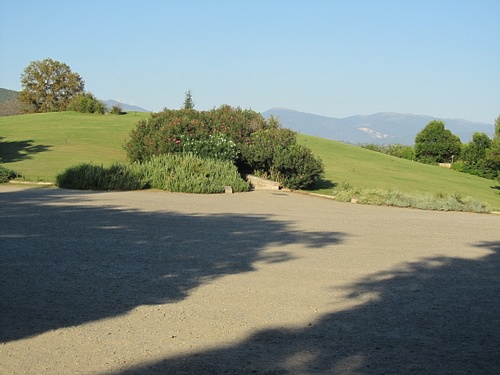
Since the discovery of the Cluster of Philip II, the city walls and its acropolis have been unearthed, along with more cemeteries and the Sanctuary of the Mother of the Gods. Over 1,000 graves have been unearthed, besides the burial clusters of royal women and earlier kings and commoners dating back to the Iron Age. Some 500 tumuli have been exposed covering over 900 hectares, revealing the extent of the ancient capital which, with its suburbs, covered some 6,500 hectares.
Identities of the Dead
Despite the early labelling of the “Cluster of Philip II”, in the absence of corroborating inscriptions, epitaphs or memorials, the excavator's conclusions were steeped in controversy. There began a 30-year-long bitter “battle of bones” waged through a series of academic papers that challenged every assumption: the tomb identities, their relative dating and “royalty”, and even the contention that the ancient capital of Aegae had been found.
When anthropologists first aged the skeletal remains found in Tomb II, it was determined that the male was 35-55 at death and the female aged 20-30. While this permitted the notion that the bones were Philip II and most logically his final far-younger bride Cleopatra who was executed soon after his death by Alexander's mother Olympias, an alternative identity persisted. They could equally be the skeletal remains of Philip's half-witted son Arrhidaeus who died 20 years later when of similar age and with an equally young bride named Adea.
Arguments for and against each candidate revolved around wounds evident or invisible on the bones of the Tomb II male when compared to the wounds Philip II reportedly received in battle. Some anthropologists and commentators claimed traumas were still visible, while others contended they were due to bone-cracking in cremation.
Recurring questions filled academic papers: did vaulted roofs like that in Tombs II exist in Greece in Philip's reign, or were they developed later following eastern inspiration? Was the hunting scene, with its depiction of a lion in the quarry, inspired by the Persian game parks witnessed on Alexander's campaign in Asia, because lions were surely extinct in Macedon by Philip's reign?
Counter-arguments pointed out that Persian influences in art had taken root in Macedon since its occupation by Darius I's advanced expedition forces in the late-6th century BCE, and vaulted structures in Persia had been built by Greek stonemasons centuries before. In Macedon the lion was a symbol of kingship and had been depicted on coins for generations, moreover, Herodotus claimed lions attacked Xerxes' camels in Macedon en route to his invasion of Greece.
New Methodology, New Momentum
By 2009 CE, the “battle of the bones” had reached a stalemate. New momentum finally came in 2010 CE when a team of anthropologists led by Professor Theodore Antikas and material scientists led by Dr Yannis Maniatis requested permits to catalogue the bones and analyse them for any attached materials. Some 350 male bones were found in the gold chest in the main chamber of Tomb II.
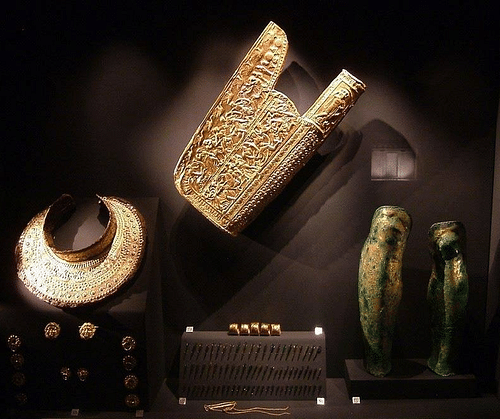
The anthropologists were able to determine the Tomb II male suffered from a respiratory problem, a chronic condition that could have been pleurisy or tuberculosis. Visible wear-and-tear markers on his spine indicated he had experienced a life on horseback, while further age-related changes to the male skeleton which had not been brought to light before, allowed the team to narrow down the estimate of the Tomb II male to 45 +/– 4 years at death. They also found a trauma on his hand which could finally correlate with one of the injuries Philip reportedly received in battle.
Under similar scrutiny, they found new incontrovertible age evidence from the previously unseen pubic bones of the female, confirming she was 32 +/- 2 years old at death. That ruled out both the earliest and the most prominent of Philip's wives who were too old when he died, and also his final teenage bride, Cleopatra, as well as the equally young Queen Adea-Eurydice, the wife of Arrhidaeus. Spinal markers made it clear she too had also endured a life in the saddle.
The Limping “Amazon”
In another “eureka moment,” the anthropological team identified a major shinbone fracture which had shortened her left leg. This conclusively united her with the antechamber armour, because the left shin guard or greave of a gilded pair was 3.5 cm shorter and also narrower than the right. Clearly, the weapons which lay beside them also belonged to her, and historians now had to unravel the mystery of a limping warrioress.
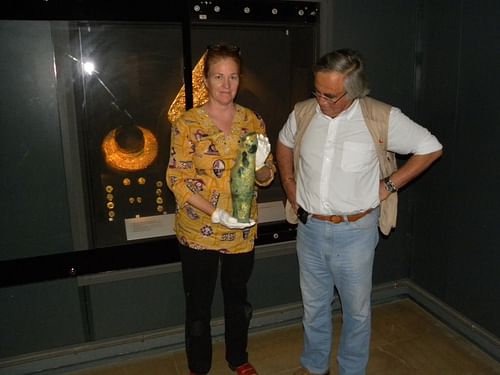
The identity debate always needed to accommodate a weapon of great mystery: with the female bones lay a gold-plated Scythian 'gorytos', the hip-slung bow-and-arrow quivers of the formidable Scythian archers. Over 1,000 excavated graves in Ukraine and the Russian Steppes have proven the existence of these female warriors, latter-day 'Amazons', who were often buried with horses, weapons, tools and their typical nomad jewellery.
At one point, Philip II allied with a Danube-region Scythian king, Atheas, who resorted to adopting the Macedonian king to seal the treaty. But a Scythian daughter was never mentioned in the sources.

There additionally remains a central conundrum attached to the Tomb II female identity: there is no mention in texts of any wife being buried with Philip II at Aegae. If the site excavator was correct, inconsistencies in the dimensions of the vaults of the two chambers forming Tomb II suggest they were built or completed in different stages, so the male and female were not necessarily cremated together or even at the same time; the different colour of her unwashed bones reinforces that.
Orphic Masks & Burials Rituals
Since 2015 CE, microscopic finds by the forensics team have included textile stains on the cremated bones and fragments of a composite material clinging to the male remains. Within it the rare white mineral huntite and Tyrian Purple were bound in layers with egg white and clay, suggested an undocumented Orphic funeral rite involved a striking ceremonial face mask, or posthumous death mask, redolent of the gold example from Mycenae labelled the “Mask of Agamemnon.”
Melted gold droplets found on the upper vertebrae begged the question of whether the male was initially wearing his wreath as flames licked the funeral pyre because his incomplete gold oak wreath showed signs of intense heat and lacked the pieces found in the pyre remains heaped on the tomb roof. An ivory-and-glass-decorated ceremonial shield also showed signs of exposure to fire. It appears the dead king was presented to the onlookers battle-ready in all his finery as the fire began cleansing his corpse, before being whipped away for interment below with his collected and washed bones.
This intricate burial protocol is strongly suggestive that whoever performed the funeral rites for the “king” in Tomb II followed Homeric convention as laid down in the Iliad and Odyssey. The bones from four horses and nine dogs had also been sacrificed that day, as described at the funeral Achilles held for Patroclus at Troy. Alexander is said to have memorised the Iliad complete. Moreover, the design of Tomb II conformed to the ideal vaulted chambers recommended by Plato in his Laws written a decade or so before Philip's death.
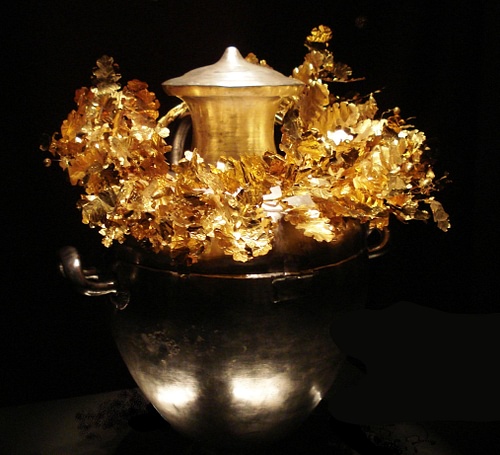
Preservation & Putrefaction: The Clothing of the Gods
The remains of funeral pyre debris on the roof of Tomb II begged a fundamental question: was the tomb already constructed before he died, like the pyramids of Egypt and the Mausoleum at Halicarnassus? Because it would have taken at least a month to dress the stone and assemble the double-chambered vaulted structure, even with a wealth of manpower at hand. Dead bodies would have corrupted within days in the October heat of the heartland of ancient Macedon.
In Homer's Trojan epic, Hector's body remained unburned for some 22 days after his death, and Achilles' 17, so some putrefaction-delaying process must have been known to the Bronze Age Greeks. There is a curious archaic Greek word used three times in the Iliad: “tapxuein,” which suggests the preserving of bodies, and here with a substance likened to “ambrosia” or the “nectar of the gods,” but possibly based on some forgotten technique. The shaft graves at Mycenae also provided signs that the inhumed, but not cremated, dead were embalmed in some way. Was the corpse of the Tomb II given similar treatment, or was a white-and-purple death mask used to hide an already-putrefying face?
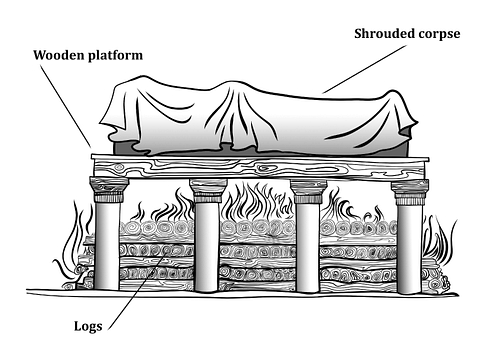
The study of the Tomb II male bones may have additionally turned up traces of fireproofing asbestos, which would have been part of a shroud worn in cremation to help separate the bones from the pyre debris, corroborating what the Roman naturalist Pliny claimed was the practice of ancient Greek kings.
The Speaking Papyrus
More recently still, in 2017 CE, Professor Richard Janko, one of the world's leading papyrologists, was able to identify letters on reassembled papyrus fragments from Tombs II and III. On a Tomb II fragment the letter Sigma was written in an older style symbol more consistent with the reign of Philip II, whereas on a fragment from Tomb III the same letter had developed into what is known as a “lunate C.” This appeared to be part of a list of chattels and tools for construction of funerary furniture, so contemporary with the sealing of the tomb. This evidence argued that the Tomb III papyrus was written some years after the sealing of Tomb II undermining the notion that Arrhidaeus was buried there.
What had become clear was that an analysis of all the contents of the tomb is required to piece together the identity puzzle, not just the skeletal remains and precious artefacts that lay scattered about the chambers. The remains of wood, leather and potentially more papyrus still sits in storage with a semi-decomposed mass of as-yet unanalysed material from the floors of the tombs.
“Final Solution” Forensics
The investigating team has since pushed for “next-generation” forensics: DNA testing, radiocarbon dating, and stable isotope analysis of the bones from unlooted Tombs II and III. DNA could reveal any genetic family relationships, C14 dating of the bones would be a cross-check to the dating of the tombs, and strontium isotope signatures might reveal where the occupants spent their early years: were they high-born royals of Macedon's capital, or the foreign brides Philip imported in his polygamous diplomacy?
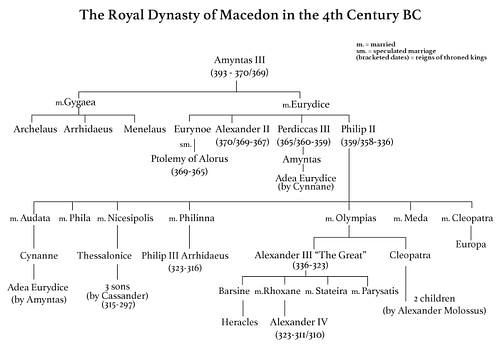
Permission was denied. Instead, the scientists were only allowed to test the scattered bones found in looted Tomb I and a nearby deliberately hidden grave near the ancient city agora or marketplace, but with no formal funding provided. Against all expectations, dating evidence and DNA results were successfully extracted, undermining yet more of the old identity theories. With the possible candidates greatly narrowed down, new DNA, radiocarbon dating and stable isotope analysis of the “king,” “queen” and “prince” in Tombs II and III might solve the identity puzzle once and for all. If permissions are forthcoming.

